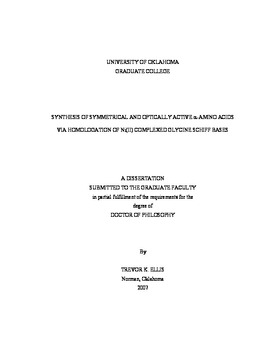| dc.contributor.advisor | Soloshonok, Vadim A., | en_US |
| dc.contributor.author | Ellis, Trevor K. | en_US |
| dc.date.accessioned | 2013-08-16T12:20:38Z | |
| dc.date.available | 2013-08-16T12:20:38Z | |
| dc.date.issued | 2007 | en_US |
| dc.identifier.uri | https://hdl.handle.net/11244/1184 | |
| dc.description.abstract | In order to overcome some of the limitations associated with the previously described Ni(II) complexed NGE a new generation of modular Ni(II) complexed NGE were introduced. The flexibility of this modular design has allowed for unprecedented methodological adaptability allowing the unification of at least four currently orthogonal methods for the preparation or resolution of alpha-amino acids. Of particular interest was the application of the Ni(II) complex of the glycine Schiff base with N-(2-acetyl-phenyl)-2-piperidylacetamide for the preparation of optically active beta-substituted pyroglutamic acids via 1,8-diazabicyclo[5.4.0]undec-7-ene (DBU) catalyzed Michael additions of the NGE and optically active beta-substituted acrylic acid derivatives in DMF. This robust process results in the formation of the beta-substituted pyroglutamic acid precursors in diastereomerically pure form and can tolerate acrylic acid derived Michael acceptors which contain a variety of sterically constraining and/or electron rich groups, such as 3,4-dichlorophenyl, i-propyl, 2-methoxyphenyl, N-tosyl-indolyl moieties, in the beta position. | en_US |
| dc.description.abstract | The focus of this research project is the synthesis of a variety of sterically constrained and chemically unique a-amino acids. Picolinic acid derived Ni(II) complexes of glycine Schiff bases proved to be a practical and efficient platform for the synthesis of a variety of sterically constrained alpha, alpha-disubstituted alpha-amino acids via homogeneous alkyl halide alkylation reactions. In particular the homologation of this picolinic acid derived Ni(II) complexed nucleophilic glycine equivalent (NGE) in dimethylformamide (DMF) with sodium t -butoxide and electrophiles such as benzyl, cinnamyl, or allyl bromide, as well as methyl, ethyl, propyl, butyl, and pentyl iodides, has proven useful for the preparation of the corresponding alpha, alpha-disubstituted alpha-amino acid derivatives in high chemical yields (>90%). | en_US |
| dc.description.abstract | Furthermore, optically active alkylamine containing ligands, such as (R)-N-(2-benzoylphenyl)-2,2-dimethyl-2-(1-phenyl-ethylamino)-ace tamide, have demonstrated potential for the separation of enantiomers of racemic alpha-amino acids via Ni(II) complex formation and chromatographic separation of the diastereomeric complexes. This procedure has proven useful for a variety of alpha-amino acids such as, alanine, valine, phenyl glycine, alpha-aminobuteric acid, and alpha-aminopentanoic acid. The metal complexed glycine equivalents required for the preparation of the alpha-amino acids described within are available via simple and concise synthetic approaches on the large scale and are extremely economical given the recyclable ligands utilized. | en_US |
| dc.format.extent | xxix, 304 leaves : | en_US |
| dc.subject | Glycine. | en_US |
| dc.subject | Chemistry, Organic. | en_US |
| dc.subject | Amino acids Synthesis. | en_US |
| dc.subject | Nucleophilic reactions. | en_US |
| dc.title | Synthesis of symmetrical and optically active alpha-amino acids via homologation of nickel(II) complexed glycine Schiff bases. | en_US |
| dc.type | Thesis | en_US |
| dc.thesis.degree | Ph.D. | en_US |
| dc.thesis.degreeDiscipline | Department of Chemistry and Biochemistry | en_US |
| dc.note | Source: Dissertation Abstracts International, Volume: 68-04, Section: B, page: 2362. | en_US |
| dc.note | Adviser: Vadim A. Soloshonok. | en_US |
| ou.identifier | (UMI)AAI3261107 | en_US |
| ou.group | College of Arts and Sciences::Department of Chemistry and Biochemistry | |
